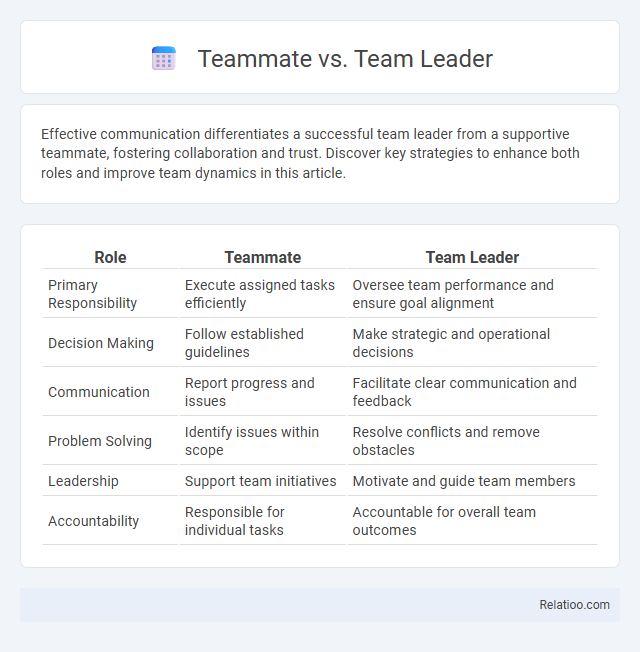Effective communication differentiates a successful team leader from a supportive teammate, fostering collaboration and trust. Discover key strategies to enhance both roles and improve team dynamics in this article.
Table of Comparison
| Role | Teammate | Team Leader |
|---|---|---|
| Primary Responsibility | Execute assigned tasks efficiently | Oversee team performance and ensure goal alignment |
| Decision Making | Follow established guidelines | Make strategic and operational decisions |
| Communication | Report progress and issues | Facilitate clear communication and feedback |
| Problem Solving | Identify issues within scope | Resolve conflicts and remove obstacles |
| Leadership | Support team initiatives | Motivate and guide team members |
| Accountability | Responsible for individual tasks | Accountable for overall team outcomes |
Defining the Roles: Teammate vs Team Leader
A teammate contributes to group objectives by collaborating, sharing ideas, and supporting tasks, while a team leader directs, motivates, and manages resources to achieve collective goals efficiently. Your role as a teammate emphasizes cooperation and skill execution, whereas the team leader focuses on strategy, decision-making, and conflict resolution. Clear distinction between these roles enhances team productivity and facilitates seamless project execution.
Key Responsibilities of a Team Leader
The Team Leader is responsible for setting clear goals, delegating tasks effectively, and ensuring team alignment to achieve project objectives. Your role includes motivating teammates, resolving conflicts, and providing guidance to enhance productivity and foster collaboration. Unlike teammates who focus on task execution, the Team Leader drives strategic decision-making and monitors overall team performance to ensure success.
Essential Qualities of an Effective Teammate
An effective teammate consistently demonstrates strong communication skills, reliability, and a collaborative mindset that fosters trust and unity within the team. Key qualities include active listening, adaptability to changing circumstances, and a commitment to supporting team goals over individual recognition. These attributes ensure seamless cooperation, boost overall productivity, and contribute to a positive team dynamic.
Decision-Making: Leadership vs Collaboration
Decision-making differs significantly between a Team Leader and Teammates, as leaders typically hold the responsibility for setting strategic direction and making final calls to ensure project alignment and goal achievement. Teammates contribute through collaborative input and consensus, providing diverse perspectives that enrich the decision-making process without assuming ultimate authority. Your role shifts between influencing outcomes with expertise as a teammate and steering decisions with accountability when leading, balancing leadership responsibilities and collaborative engagement.
Communication Styles: Teammate vs Team Leader
Effective communication styles differ significantly between a team leader and a teammate, with the leader focusing on clear, directive communication to align the team's goals and prioritize tasks. Teammates typically engage in collaborative, supportive dialogue that fosters trust and encourages idea-sharing within the group. Understanding these distinctions in communication styles helps you adapt and contribute more effectively to your team's overall success.
Conflict Resolution in Teams
Effective conflict resolution in teams hinges on the distinct roles of teammates and team leaders; while teammates contribute diverse perspectives and collaborative problem-solving, team leaders guide the mediation process by facilitating open communication and maintaining focus on shared goals. Team leaders employ conflict resolution strategies such as active listening, empathy, and negotiation skills to de-escalate tensions and promote consensus. Teammates support this process by practicing mutual respect and adopting a solution-oriented mindset, fostering a cohesive and productive team environment.
Delegation and Accountability
Your effectiveness in delegation significantly differs between a teammate, team leader, and a manager, with team leaders holding primary responsibility for assigning tasks strategically and ensuring accountability. Team leaders delegate tasks based on individual strengths, maintaining oversight to guarantee completion and quality, whereas teammates typically focus on executing assigned work without formal delegation authority. Accountability rests heavily on team leaders to monitor progress and provide feedback, while teammates bear accountability for their personal contributions within the team.
Influence and Motivation: Leader vs Member
Team leaders wield significant influence by shaping team goals, setting expectations, and motivating members through vision and support, fostering a productive and cohesive environment. Teammates primarily influence team dynamics through collaboration, feedback, and peer support, contributing to collective motivation and problem-solving. While leaders drive motivation by empowering and guiding, teammates sustain it by maintaining communication and fostering trust within the group.
Performance Metrics: Measuring Team and Individual Success
Performance metrics for teammates typically emphasize task completion, quality of work, and collaboration effectiveness, while team leaders are evaluated based on overall team productivity, goal achievement, and leadership impact on team morale. Individual success in team roles is often measured through key performance indicators (KPIs) aligned with specific responsibilities, such as meeting deadlines for teammates and strategic decision-making for team leaders. The comparison between teammates and leaders in performance metrics highlights the balance between individual contributions and the ability to drive collective results.
Transitioning from Teammate to Team Leader
Transitioning from a Teammate to a Team Leader involves developing leadership skills such as communication, decision-making, and conflict resolution to effectively guide and motivate your team. Understanding team dynamics from both perspectives enables seamless delegation and fosters collaboration, ensuring project goals are met efficiently. Your success as a leader depends on balancing respect for teammates' insights while taking responsibility for overall team performance.

Infographic: Teammate vs Team Leader
 relatioo.com
relatioo.com